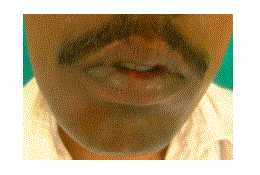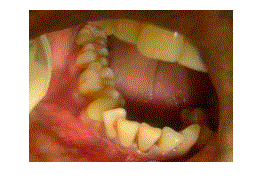ISSN ONLINE(2319-8753)PRINT(2347-6710)
ISSN ONLINE(2319-8753)PRINT(2347-6710)
Dr. Sudharani Biradar1, Dr. Anita Munde2, Dr. Safia Shoeb3, Dr. Shweta Mishra1, Dr. Monica Juvekar1
|
| Related article at Pubmed, Scholar Google |
Visit for more related articles at International Journal of Innovative Research in Science, Engineering and Technology
Calcifying epithelial odontogenic tumor (CEOT) is a rare benign, but locally infiltrating odontogenic neoplasm. It accounts for less than 1% of all odontogenic tumors. In approximately 52% of the cases, the tumor is associated with impacted teeth and is twice as prevalent in the mandible than the maxilla. This paper presents a case of CEOT associated with an impacted mandibular canine which is very rare and adds on to the previous mentioned CEOTs in the literature.
Keywords |
| calcifying odontogenic tumor, odontogenic tumor, impacted tooth |
I. INTRODUCTION |
| The calcifying epithelial odontogenic tumor (CEOT), is a benign neoplasm of odontogenic origin.[1] It is a rare tumor accounting for less than 1% of all odontogenic tumors.[2] It is a benign, though occasionally locally invasive, slow growing neoplasm. It was first described as a separate entity in 1955 by Pindborg and in 1958 he expanded the description. It has since been referred to as Pindborg tumour. According to the WHO classification [3], CEOT is a benign odontogenic tumour, most frequently presenting as a painless slow growing swelling. In approximately 52% of the cases, the tumour is associated with impacted teeth and is twice as prevalent in the mandible than the maxilla.[4] |
| This article reports a case of CEOT of the mandible in a 30 year old male patient. |
II. CASE REPORT |
| A 30 yrs old male patient was reported to the Department of Oral Medicine and Radiology with the complaint of swelling in lower right region of jaw since 6 months. The swelling was slow in growth and initially was associated with mild pain. There was no history of trauma and pus discharge present with the swelling. Patient had taken medications but there was no reduction in the size of the swelling. Personal history revealed that the patient was a nonsmoker and did not have any other tobacco habits. The family and medical history was non contributory. |
| On extraoral examination, an extraoral diffuse swelling was seen in the right side of lower third of face extending anteriorly, 1cm away from symphysis region to posteriorly, 3cms anterior to the angle of mandible. Superiorly it extends from line joining the right corner of mouth and tragus of ear and inferiorly, to the inferior border of mandible, of size approx.4X3 cms. The overlying skin was normal in color with smooth surface. On palpation the swelling was hard in consistency and non tender. Bilateral solitary submandibular lymphnodes were palpable, mobile, firm and tender (Fig 1). |
| On intraoral examination, the swelling was extending horizontally, from lower right central incisor to lower right first molar, vertically, from gingival margin to deep in the vestibule. The overlying mucosa was normal in color and intact. The swelling was bony hard in consistency and non tender. Expansion was palpable of both buccal and lingual cortical plates, more prominently on the buccal aspect. The lower right canine was missing and lower first and second premolars were lingually inclined (Fig 2). |
| Radiographic examination (OPG, mandibular occlusal and intraoral periapical radiographs) showed a well defined mixed radiopaque-radiolucent lesion in the right side of the mandible, extending horizontally from lower right central incisor to lower right second molar and vertically from alveolar crest to the inferior border of mandible. An impacted lower right canine was seen within the lesion and was displaced towards inferior border of mandible. Numerous radiopaque foci of calcifications were seen scattered within the lesion of varying size and density and they were seen more prominently close to the crown of impacted tooth. The lower first and second premolars were mesially inclined (Fig 3a, 3b, 3c). In occlusal radiograph, expansion and thinning of both buccal and lingual cortical plates was seen which was more prominent on the buccal aspect (Fig 4a, 4b). |
| Depending on the clinical and radiographic features, provisional diagnosis of benign odontogenic tumor such as calcifying epithelial odontogenic tumor was given and in differential diagnosis, calcifying odontogenic cyst, cementoossifying fibroma , ameloblastic fibro-odontome and adenomatoid odontogenic tumor were given. |
| The tumor was excised with wide surgical margins and the post-operative period was uneventful. Histopathologically, the tumor comprised of fibrous connective tissue capsule and bony trabeculae at periphery. The section was chiefly composed of numerous calcific deposits showing variable staining pattern (basophilic and eosinophilic). These calcifications were chiefly globular or oval in shape resembling “Liesegang rings”. There were areas showing islands of odontogenic epithelial cells. Some of them were showing eosinophilic cytoplasm and were surrounded by eosinophilic material undergoing calcification. The lesion also showed numerous fibrocellular septae interspersed between the epithelial islands and calcific deposits. The overall features were suggestive of calcifying epithelial odontogenic tumor. |
| The patient is under observation for the past one and half years without any signs of recurrence. |
III. DISCUSSION |
| CEOT is an uncommon neoplasm accounting for less than 1% of all odontogenic tumors. This rare tumor was first described as a separate pathologic entity by a Dutch pathologist Jens Jorgen Pindborg in 1955.[1] In honor to this internationally renowned oral and maxillofacial pathologist, this tumor is also known as Pindborg tumour. The histogenesis of this tumor remains elusive. Some pathologists suggest that it is derived from the stratum intermedium layer of the enamel organ in the tooth development stage, others favor a different hypothesis in which, this tumour may arise from remnants of the primitive dental lamina found in the initial stage of odontogenesis.[5,6] According to the WHO classification [3], CEOT is a benign odontogenic tumour, most frequently presenting as a painless slow growing swelling. The tumor is similar in behavior to ameloblastoma but has a slightly lesser recurrence rate after surgery. |
| It is most commonly reported in patients during the 4th, 5th, and 6th decades of life. The mean age range is 33–43 years of age. In 113 cases reviewed by Franklin and Pindborg, patients ranged from 8 to 92 years of age with mean at 40 years.[4] In 2004, Cicconetti and colleagues reported that tumor more frequently affects adults in the age range of 40 to 60 years with peak incidence in the 5th decade with an equal sex distribution.[5]The age of the patient in the present case was 30 yrs, slightly younger than the reported age range. |
| The CEOT may occur as intraosseous (87.8%) tumours or as extraosseous tumours(6.1 %).[6] |
| The CEOT has also been reported as hybrid tumours in combination with adenomatoid odontogenic tumour (AOT) which has been reported to be frequent in women and present at a younger age. According to Langlais et al, CEOTs can be seen associated with dentigerous cyst, adenomatoid odontogenic tumor and odontoma.[7] |
| More than 200 cases have been reported in the literature, with most being reported in the mandible and very few in maxilla. The intraosseous CEOT are found primarily in the mandible (mandible:maxilla ratio 2:1), especially in the premolar and molar regions. The extraosseous variant exhibits a preponderance to the anterior gingival regions.[8] 52% of the tumors are associated with an impacted tooth, most often the first or second molars.[4,7] This case report presents a lesion with an impacted mandibular canine, which is rarest of the rare. |
| CEOT are slow growing, expansile, painless masses that cause expansion of the cortical plates but occasionally patients may report with pain. Nasal stuffiness, epistaxis, proptosis and headache are the symptoms when the maxilla is involved. The extraosseous variant usually presents as a nodular swelling.[9] |
| Radiographically, depending on stages of development, CEOT may present variable radiographic appearances. It has a variety of appearances; 58% of CEOTs are unilocular, 27% are multilocular, and 15% are nonloculated.[10] In about half of cases, radiographs taken early in the development of these tumors reveal a radiolucent area around the crown of a mature, unerupted tooth. Multiple radiopacities of varying size may develop within the radiolucent area and occasionally there are extensive areas of calcification that cause the lesion to become radiopaque [11]. In addition, small, thin, opaque trabeculae may cross the radiolucency in many directions, producing a multilocular or honeycomb pattern. Clustering of radiopaque flecks at the coronal area of the impacted teeth is a feature originally described by Pindborg,[2] and considered by others to be typical for CEOT.[3]The mixed radiolucent and radiopaque pattern occurred most often (65%) followed by the completely radiolucent pattern (32%) and least often the totally radiopaque ‘‘wind driven snow’’ pattern (3%).[11] A specific pattern of tooth displacement, manifested by inferior displacement, as seen in the present case, with the apex penetrating the inferior cortex, was described by Pindborg[1] in his initial report and suggested by Langlais et al.[5] as characteristic. Root resorption was an uncommon (4%) finding.[10] |
| Advanced imaging technique plays an important role in evaluating the extent of facial bones and skull involvement and has a crucial role in planning the surgery. The CT of this tumor usually shows a well-defined mass with thinning of the cortical plates and contains scattered radiopaque foci. When CEOT is analyzed by MRI, it reveals predominantly a hypointense lesion on T1-weighted images and mixed hyperintense lesion on T2-weighted images.[12] |
| According to Pindborg, the characteristic histologic criteria for the diagnosis of CEOT are sheets of large polygonal epithelial cells that have well-defined borders and often show prominent intercellular bridges. There is usually pleomorphism of the epithelial cells. Nuclei are often prominent and show considerable variation in size, shape, and number. Cellular abnormalities are frequent, whereas mitotic figures are rarely seen. Cytoplasm is abundant and eosinophilic. Varying amounts of an extracellular amyloid-like material that stains positive with Congo red stain in polarized light is also typical of these tumors. Concentric calcified masses with a Liesegang’s rings calcification pattern, as seen in the present case, are also pathognomonic for this tumor.[2] |
| CEOT has a variable biologic behavior ranging from very mild to moderate invasiveness.[13] The literature shows variations regarding radicality of the surgical treatment needed. There are very few evidence-based treatment recommendations because of the paucity of cases reported. Methods of treatment can range from simple enucleation or curettage to hemimandibulectomy or hemimaxillectomy. Enucleation with a margin of normal tissue is usually recommended for mandibular lesions. Franklin and Pindborg, in their review of 113 cases, suggested that marginal resection with a rim of normal tissue is advisable.[4] CEOT of the maxilla should be treated more aggressively as maxillary tumors grow more rapidly and are usually not well confined. Treatment, however, should be individualized for each case. In this case, CEOT was treated conservatively via enucleation. Local recurrence rates may range from 14 to 20%, and malignant transformation is rare, with only three cases reported. [4,14] CEOT has a much lower recurrence rate than ameloblastoma. A follow-up of minimum 5–10 years may be necessary because of the very slow growth rate of this tumor.[4] |
 |
 |
IV. CONCLUSION |
| In conclusion, this report features a case of mandibular CEOT with an impacted canine which is rare. This case clinically was appearing as a dentigerous cyst, but radiologically mixed radiopaque-radiolucent appearance was seen. This is to emphasize the need to correlate radiographic, clinical and histopathological findings to arrive at the correct diagnosis and treatment planning. |
References |
|